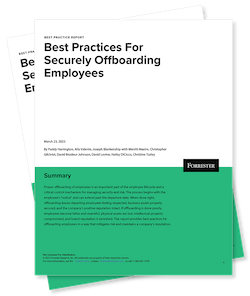Employees come and go. But when it’s time for them to go, things can get messy real fast. The security of your proprietary data, intellectual property and devices are all at risk.
In fact, there’s a 1 in 3 chance you’ll lose critical IP when an employee quits, according to the 2023 Data Exposure Report.
In many companies, the offboarding process often takes a back seat. When it’s not managed effectively, the tasks are fragmented and handled by different departments in isolation. This disjointed approach can lead to missed steps, increased risk of data loss and poorly managed access permissions.
Forrester’s Best Practices for Securely Offboarding Employees report found that security teams overlook the importance of working with both risk/compliance and HR teams during this time, which further contributes to disjointed, ineffective offboarding processes.
Only 8% of the security technology decision-makers surveyed currently work with the risk/compliance teams as part of offboarding, and those that work with HR teams was only slightly better at 10%.
So how do you make sure your data doesn’t walk out the door with departing employees? Follow these five tips recommended by Forrester.
1. Develop clear offboarding workflows
Every employee exit is different. Forrester says having multiple processes in place for various scenarios is key: “No single process works every time. Factors like the type of departure, role, location, data access…all determine how the process will flow.”
To address these complexities, HR, IT and security leaders should create custom workflows for different employee departure scenarios. These processes must be well-documented to ensure compliance with company policies and provide a clear record for accountability and transparency.
2. Train your teams
Many companies focus their training on onboarding and neglect offboarding. But Forrester finds that contextual offboarding training ensures people know what part they play, and what they’ll be expected to do when the time comes.
The recommendation is to create training that is tailored to the specific roles and responsibilities of individuals involved in the offboarding process. This sends a clear signal of what employees can or can’t do, limiting the chances of data loss and ensuring a smoother and more efficient transition when the need arises.
3. Leverage technology
Managing offboarding via manual processes is risky. By automating workflows and incorporating technology solutions instead, businesses can establish standardized workflows that cover various aspects of offboarding, from revoking application access to backing up data and terminating user accounts.
In short, technology streamlines the offboarding process, making it consistent, efficient and manageable while reducing the chances of errors or oversights.
4. Balance security with empathy
People leave their jobs for various reasons, like retirement, changing employers or being let go. It’s crucial for business leaders to strike a balance between empathy and security during offboarding. On one hand, the human aspect of the process (such as knowledge transfers and exit interviews) ensures a well-rounded and respectful departure for employees, while at the same time allowing the offboarding process to be well-integrated into overall data security practices.
As Forrester explains: “How business leaders balance these needs can directly impact the company’s brand, performance and state of the employees who remain with the company.”
5. Protect both intellectual and physical property
In today’s dynamic work environment where remote and ‘anywhere work’ is the norm, physical assets are increasingly outside a company’s direct control. Forrester notes, “When it comes to asset recovery, some business leaders we talked to said they consider the asset gone as soon as it leaves the business offices and upon termination; they then reset computing devices to their default configuration, removing corporate data.”
It’s important to have solutions in place that can safeguard not only intellectual property but also physical devices. These should be integrated into your onboarding and offboarding workflows, so their use is automated and company property is protected.
Ready to move from knowledge to action? Safeguard your data from exiting employees with Code42
Do you have visibility into what employees take with them when they leave? Like many security leaders, chances are you don’t. No matter whether employees leave with critical data in a malicious manner or because they feel ownership over their work, insider-driven data exposure, loss, leak and theft events could cost companies an average of $15 million per incident.
Code42 Incydr gives you the visibility and control needed to make your offboarding process both easier and more effective. It allows you to immediately detect and prevent transfer of sensitive data. It integrated with HR systems to automate this workflow so you gain visibility into data movement and detect file sharing and exfiltration across endpoints, cloud apps, browsers and email.
These approaches support your security team’s productivity so that they’ll be able to see and stop data loss caused by departing employees, without burdening your security team.

